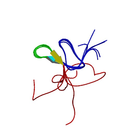| Record Information |
|---|
| Version | 2.0 |
|---|
| Creation Date | 2009-07-03 22:18:58 UTC |
|---|
| Update Date | 2014-12-24 20:25:37 UTC |
|---|
| Accession Number | T3D2494 |
|---|
| Identification |
|---|
| Common Name | omega-Agatoxin |
|---|
| Class | Protein |
|---|
| Description | Agatoxins are a class of chemically diverse polyamine and peptide toxins which are isolated from the venom of various spiders, in particular the North American funnel-web spider (Agelenopsis aperta), after which agatoxins are named. omega-Agatoxins are subdivided in four classes based on their primary structures, biochemical properties and calcium channels specificity. They block the calcium channels in the presynaptic terminals of the neuromuscular junction in insects and vertebrates. (1) |
|---|
| Compound Type | - Amide
- Amine
- Animal Toxin
- Natural Compound
- Organic Compound
- Protein
- Spider Toxin
|
|---|
| Protein Structure |  |
|---|
| Synonyms | | Synonym | | Omega-Aga-1A | | Omega-agatoxin 1A | | Omega-agatoxin-1A | | Omegat agatoxin 1A | | w-agatoxin 1A |
|
|---|
| Chemical Formula | Not Available |
|---|
| Average Molecular Mass | 12807.575 g/mol |
|---|
| CAS Registry Number | 145017-83-0 |
|---|
| Sequence | Not Available |
|---|
| Chemical Taxonomy |
|---|
| Description | Not Available |
|---|
| Kingdom | Organic Compounds |
|---|
| Super Class | Organic Acids |
|---|
| Class | Carboxylic Acids and Derivatives |
|---|
| Sub Class | Amino Acids, Peptides, and Analogues |
|---|
| Direct Parent | Peptides |
|---|
| Alternative Parents | Not Available |
|---|
| Substituents | Not Available |
|---|
| Molecular Framework | Not Available |
|---|
| External Descriptors | Not Available |
|---|
| Biological Properties |
|---|
| Status | Detected and Not Quantified |
|---|
| Origin | Exogenous |
|---|
| Cellular Locations | Not Available |
|---|
| Biofluid Locations | Not Available |
|---|
| Tissue Locations | Not Available |
|---|
| Pathways | Not Available |
|---|
| Applications | Not Available |
|---|
| Biological Roles | Not Available |
|---|
| Chemical Roles | Not Available |
|---|
| Physical Properties |
|---|
| State | Liquid |
|---|
| Appearance | Clear solution. |
|---|
| Experimental Properties | | Property | Value |
|---|
| Melting Point | Not Available | | Boiling Point | Not Available | | Solubility | >10 mg/mL | | LogP | Not Available |
|
|---|
| Predicted Properties | Not Available |
|---|
| Spectra |
|---|
| Spectra | | Spectrum Type | Description | Splash Key | Deposition Date | View |
|---|
|
|---|
| Toxicity Profile |
|---|
| Route of Exposure | Injection (sting/bite) (3) |
|---|
| Mechanism of Toxicity | omega-Agatoxins block the calcium channels in the presynaptic terminals of the neuromuscular junction in insects and vertebrates. This reduces calcium influx, resulting in a decreased release of neurotransmitters in the synaptic cleft. (1) |
|---|
| Metabolism | Free toxin may be removed by opsonization via the reticuloendothelial system (primarily the liver and kidneys) or it may be degraded through cellular internalization via the lysosomes. Lysosomes are membrane-enclosed organelles that contain an array of digestive enzymes, including several proteases. |
|---|
| Toxicity Values | Not Available |
|---|
| Lethal Dose | Not Available |
|---|
| Carcinogenicity (IARC Classification) | No indication of carcinogenicity to humans (not listed by IARC). |
|---|
| Uses/Sources | Agatoxins are a class of chemically diverse polyamine and peptide toxins which are isolated from the venom of various spiders, in particular the North American funnel-web spider (Agelenopsis aperta). (1) |
|---|
| Minimum Risk Level | Not Available |
|---|
| Health Effects | omega-Agatoxin causes spasms leading to a progressive paralysis which will eventually lead to death in insects. (1) |
|---|
| Symptoms | The bites of funnel-web spiders may cause tingling around the mouth and tongue, facial muscle twitching, nausea, vomiting, profuse sweating, salivation, and shortness of breath. Patients may also rapidly develop agitation, confusion and coma associated with hypertension, metabolic acidosis, dilation of the pupils, generalised muscle twitching and pulmonary oedema. (2) |
|---|
| Treatment | First aid for funnel-web bites consists of applying a pressure immobilization bandage to slow venom movement. Further supportive care may be necessary, but the mainstay of treatment is antivenom. (2) |
|---|
| Normal Concentrations |
|---|
| Not Available |
|---|
| Abnormal Concentrations |
|---|
| Not Available |
|---|
| External Links |
|---|
| DrugBank ID | Not Available |
|---|
| HMDB ID | Not Available |
|---|
| PubChem Compound ID | Not Available |
|---|
| ChEMBL ID | Not Available |
|---|
| ChemSpider ID | Not Available |
|---|
| KEGG ID | Not Available |
|---|
| UniProt ID | P15969 |
|---|
| OMIM ID | |
|---|
| ChEBI ID | Not Available |
|---|
| BioCyc ID | Not Available |
|---|
| CTD ID | Not Available |
|---|
| Stitch ID | omega-Agatoxin |
|---|
| PDB ID | Not Available |
|---|
| ACToR ID | Not Available |
|---|
| Wikipedia Link | Not Available |
|---|
| References |
|---|
| Synthesis Reference | Not Available |
|---|
| MSDS | Not Available |
|---|
| General References | - Wikipedia. Agatoxin. Last Updated 28 March 2009. [Link]
- Wikipedia. Australian funnel-web spider. Last Updated 6 July 2009. [Link]
- Wikipedia. Spider toxin. Last Updated 9 January 2009. [Link]
|
|---|
| Gene Regulation |
|---|
| Up-Regulated Genes | Not Available |
|---|
| Down-Regulated Genes | Not Available |
|---|

